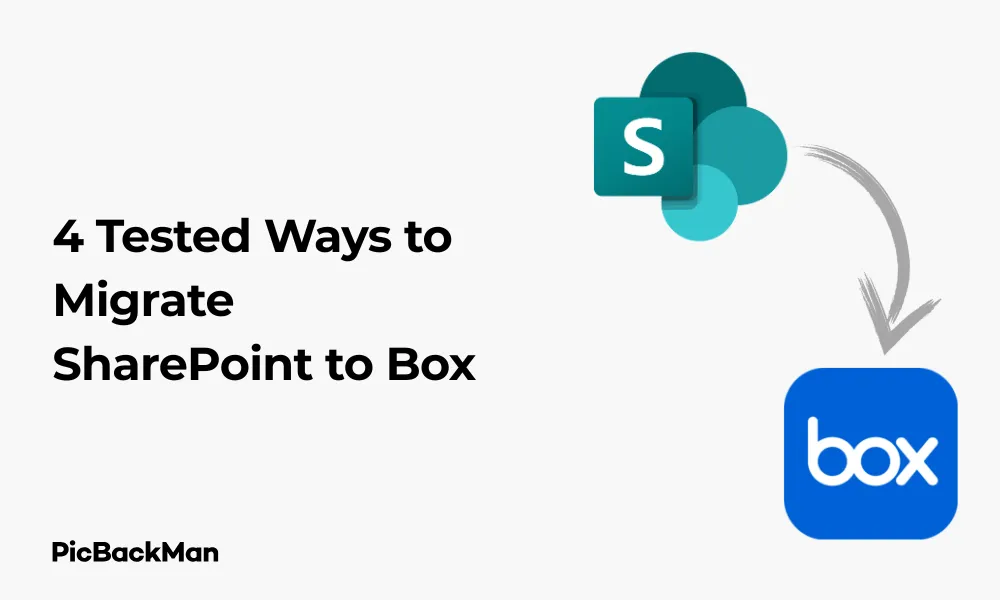
Why is it the #1 bulk uploader?
- Insanely fast!
- Maintains folder structure.
- 100% automated upload.
- Supports RAW files.
- Privacy default.
How can you get started?
Download PicBackMan and start free, then upgrade to annual or lifetime plan as per your needs. Join 100,000+ users who trust PicBackMan for keeping their precious memories safe in multiple online accounts.
“Your pictures are scattered. PicBackMan helps you bring order to your digital memories.”
4 Tested Ways to Migrate SharePoint to Box


Migrating from SharePoint to Box can seem like a daunting task, but with the right approach, you can make this transition smoothly. Whether you're looking to improve collaboration, reduce costs, or simplify your content management, moving from SharePoint to Box offers many benefits. In this guide, I'll walk you through four tested methods to migrate your data, complete with step-by-step instructions and practical tips based on real-world experience.
Why Migrate from SharePoint to Box?
Before diving into the migration methods, let's quickly understand why many organizations choose to move from SharePoint to Box:
- Simpler user interface and better user adoption
- Lower maintenance costs
- Improved mobile access
- Better sharing external capabilities
- Reduced IT overhead
- Stronger security and compliance features
If these benefits align with your organization's goals, you're making a smart choice to migrate. Now, let's explore the four proven methods to make this transition happen.
Method 1: Manual Download and Upload
The manual approach is the simplest method requiring no special tools, but it works best for smaller migrations with limited content.
When to Use This Method
- Small amount of data (less than 10GB)
- Limited number of files and folders
- No budget for migration tools
- Need to be selective about what content moves
Step-by-Step Process
1. Prepare Your Content
Start by organizing your SharePoint content. Identify what needs to be migrated and what can be archived or deleted.
- Create an inventory of your SharePoint sites, libraries, and folders
- Decide on a folder structure for Box that makes sense for your team
- Clean up outdated or unnecessary files to avoid migrating clutter
2. Download Files from SharePoint
Download your content from SharePoint to your local computer:
- Navigate to the SharePoint library containing your files
- Select multiple files by holding Ctrl while clicking (or select all with Ctrl+A)
- Click "Download" in the top menu
- Save the files to a temporary folder on your computer
3. Upload Files to Box
Now upload your downloaded files to Box:
- Log in to your Box account
- Navigate to the destination folder
- Click "Upload" and select "Files" or "Folder"
- Select the files you downloaded from SharePoint
- Wait for the upload to complete
4. Verify Your Migration
After uploading, verify that everything transferred correctly:
- Compare file counts between SharePoint and Box
- Open a sample of documents to ensure they're intact
- Check that folder structures match your plan
Pros and Cons
| Pros | Cons |
|---|---|
| No additional tools needed | Very time-consuming for large migrations |
| Complete control over what gets migrated | Metadata and permissions are lost |
| Good for selective migration | Higher risk of human error |
| No cost | Version history is lost |
Method 2: Using Box Shuttle
Box Shuttle is Box's official migration service designed specifically for enterprise-level migrations from systems like SharePoint.
When to Use This Method
- Large-scale migrations (terabytes of data)
- Need to preserve metadata and permissions
- Complex migration scenarios
- Enterprise customers with migration budget
Step-by-Step Process
1. Engage with Box
Start by contacting Box to set up the Shuttle service:
- Reach out to your Box account representative or sales team
- Schedule an initial consultation to discuss your migration needs
- Get a quote based on your data volume and complexity
2. Planning Phase
Work with Box consultants to create a detailed migration plan:
- Complete a content inventory of your SharePoint environment
- Map SharePoint sites and libraries to Box folders
- Define permission mapping strategy
- Identify metadata to preserve
- Create a migration timeline
3. Test Migration
Before moving everything, conduct a test migration:
- Select a representative sample of content
- Run a pilot migration to a test box environment
- Verify that files, folders, permissions, and metadata transferred correctly
- Make adjustments to the migration plan based on test results
4. Full Migration
Once testing is complete, proceed with the full migration:
- Box will deploy their Shuttle technology to extract content from SharePoint
- Content is securely transferred to Box according to your mapping plan
- Monitor progress through Box's migration dashboard
- Address any issues that arise during migration
5. Validation and Cutover
After migration is complete:
- Verify that all content has been transferred correctly
- Check that permissions are working as expected
- Confirm metadata has been preserved according to plan
- Train users on the new Box environment
- Set SharePoint to read-only or decommission as appropriate
Pros and Cons
| Pros | Cons |
|---|---|
| Professional service with expert support | Significant cost |
| Preserves metadata and permissions | Less control over day-to-day migration process |
| Handles large volumes efficiently | Longer setup time |
| Minimizes disruption to business | Requires coordination with Box's schedule |
Method 3: Using Third-Party Migration Tools
Several third-party tools specialize in SharePoint to Box migrations, offering a middle ground between manual methods and Box Shuttle.
When to Use This Method
- Medium to large migrations
- Need for automation but with more control
- Budget constraints that rule out Box Shuttle
- Need to preserve some metadata
Popular Third-Party Tools
- CloudFastPath
- SkySync
- ShareGate
- Mover.io (now part of Microsoft)
Step-by-Step Process
1. Select and Set Up Your Tool
Choose the right migration tool for your needs:
- Research options based on your specific requirements
- Request demos from vendors to see tools in action
- Purchase licenses or subscriptions
- Install any required components (some tools are cloud-based and need no installation)
2. Connect Source and Destination
Set up connections to both systems:
- Configure SharePoint connection with admin credentials
- Set up Box connection using API credentials
- Test both connections to ensure they work properly
3. Map Content and Settings
Create a migration plan within the tool:
- Map SharePoint sites and libraries to Box folders
- Configure permission mapping
- Select metadata fields to transfer
- Set up any content filtering (optional)
4. Run Test Migration
Test with a subset of your data:
- Select a representative sample of content
- Run a test migration to verify settings
- Check results for accuracy
- Adjust settings as needed
5. Execute Full Migration
Once testing is complete, run the full migration:
- Schedule the migration during off-hours if possible
- Start the migration process
- Monitor progress through the tool's dashboard
- Address any errors that occur
6. Verify and Finalize
After migration is complete:
- Review migration reports from the tool
- Spot-check content in Box
- Verify permissions are working correctly
- Run any post-migration scripts if needed
Pros and Cons
| Pros | Cons |
|---|---|
| More affordable than Box Shuttle | Less specialized support than Box Shuttle |
| Preserves some metadata and permissions | May require technical expertise to configure |
| Automates much of the process | Quality and features vary between tools |
| More control than Box Shuttle | Potential for API limitations |
Method 4: API-Based Custom Migration
For organizations with unique requirements or in-house development resources, creating a custom migration solution using Box and SharePoint APIs offers maximum flexibility.
When to Use This Method
- Highly specialized migration requirements
- Need for extensive customization
- Available development resources
- Integration with other systems during migration
Step-by-Step Process
1. Develop a Migration Strategy
Plan your custom approach:
- Document specific migration requirements
- Identify what data and metadata needs to be preserved
- Determine how permissions will be mapped
- Plan for handling special cases or content types
2. Set Up Development Environment
Prepare your development tools:
- Create a Box developer account
- Register a Box application to get API credentials
- Set up SharePoint API access
- Choose programming language (Python, C#, Node.js, etc.)
- Install necessary libraries and SDKs
3. Develop Migration Code
Write code to handle the migration:
- Create functions to authenticate with both systems
- Develop code to read SharePoint structure and content
- Write functions to create corresponding structure in Box
- Implement file transfer logic
- Add error handling and logging
- Build permission and metadata mapping functionality
4. Test in Development Environment
Thoroughly test your code:
- Run tests with sample data
- Verify file integrity after transfer
- Check that folder structures are created correctly
- Confirm permissions are applied properly
- Test error handling by simulating failures
5. Run Pilot Migration
Test with real but limited data:
- Select a small department or project for pilot migration
- Run your custom migration tool
- Collect feedback from pilot users
- Make adjustments based on results
6. Execute Full Migration
Roll out to the entire organization:
- Plan migration in phases if necessary
- Run migration during low-usage periods
- Monitor progress and system performance
- Address any issues that arise
7. Document and Maintain
Finalize your custom solution:
- Document your code and processes
- Create reports on migration results
- Consider maintaining the tool for future migrations
Pros and Cons
| Pros | Cons |
|---|---|
| Maximum flexibility and customization | Requires significant development resources |
| Can handle unique or complex requirements | Longer development time |
| Full control over the migration process | Need to maintain and troubleshoot custom code |
| Can integrate with other systems or workflows | Risk of API limitations or changes |
Comparing the Four Migration Methods
To help you choose the right method for your organization, here's a comparison of all four approaches:
| Feature | Manual Method | Box Shuttle | Third-Party Tools | Custom API Solution |
|---|---|---|---|---|
| Cost | Free | High | Medium | Development costs |
| Suitable Data Volume | <10GB | Unlimited | Up to several TB | Depends on implementation |
| Preserves Metadata | No | Yes | Partial | Yes (customizable) |
| Preserves Permissions | No | Yes | Partial | Yes (customizable) |
| Technical Expertise Required | Low | Low | Medium | High |
| Time to Implement | Fast setup, slow execution | Slow setup, fast execution | Medium setup, fast execution | Slow setup, fast execution |
Best Practices for SharePoint to Box Migration
Regardless of which method you choose, these best practices will help ensure a successful migration:
Before Migration
- Audit your SharePoint content to identify what needs to be migrated
- Clean up unnecessary or outdated content
- Plan your Box folder structure to improve organization
- Map user permissions from SharePoint to Box
- Communicate the migration plan to all stakeholders
- Train users on Box before migration
During Migration
- Start with a pilot migration of non-critical content
- Monitor system performance during migration
- Keep users informed of progress and any temporary access issues
- Document any errors or issues for troubleshooting
- Have a rollback plan in case of major problems
After Migration
- Verify that all content has been migrated correctly
- Check permissions to ensure appropriate access
- Collect feedback from users
- Provide additional training as needed
- Set SharePoint to read-only temporarily before full decommissioning
- Document the final state of the migration
Common Challenges and Solutions
Be prepared to address these common challenges during your migration:
1. File Path Length Limitations
Challenge: Box has a 255-character limit for file paths.
Solution: Identify long paths in SharePoint before migration and restructure folders to reduce path length.
2. Special Characters in Filenames
Challenge: Some characters allowed in SharePoint may cause issues in Box.
Solution: Scan for and rename files with problematic characters (like * ? : / | < > " #) before migration.
3. Version History
Challenge: Preserving version history can be difficult.
Solution: If version history is critical, use Box Shuttle or a custom API solution that can handle versions.
4. SharePoint Workflows and Custom Features
Challenge: SharePoint workflows and custom features don't transfer to Box.
Solution: Document existing workflows and recreate them using Box's automation features or third-party integrations.
5. User Adoption
Challenge: Users may resist changing from familiar SharePoint to Box.
Solution: Provide comprehensive training, create quick reference guides, and highlight Box's advantages.
Quick Tip to ensure your videos never go missing
Videos are precious memories and all of us never want to lose them to hard disk crashes or missing drives. PicBackMan is the easiest and simplest way to keep your videos safely backed up in one or more online accounts.
Simply download PicBackMan (it's free!) , register your account, connect to your online store and tell PicBackMan where your videos are - PicBackMan does the rest, automatically. It bulk uploads all videos and keeps looking for new ones and uploads those too. You don't have to ever touch it.
Post-Migration: Making the Most of Box
After successfully migrating to Box, take advantage of these features to maximize your return on investment:
Collaboration Features
- Box Notes for collaborative documents
- Comments and tasks for feedback and action items
- Box Relay for workflow automation
- External collaboration with partners and clients
Security and Compliance
- Set up appropriate security policies
- Configure Box Governance for retention policies
- Implement Box Shield for advanced security
- Set up audit logs and reporting
Integration with Other Tools
- Connect Box to your productivity suite (Office 365, Google Workspace)
- Set up integrations with CRM, project management tools, etc.
- Explore Box's app ecosystem for additional functionality
Conclusion
Migrating from SharePoint to Box is a significant undertaking, but with the right approach, it can lead to improved collaboration, reduced costs, and a more user-friendly content management experience. By choosing the migration method that best fits your organization's size, budget, and requirements, you can make this transition smoothly and successfully.
Whether you opt for the simple manual approach, the fully-supported Box Shuttle service, a third-party migration tool, or a custom API solution, careful planning and following best practices will help ensure your data moves securely and completely. Remember that migration is not just about moving files—it's an opportunity to reorganize, clean up, and improve your content management practices.
With your content successfully migrated to Box, your organization can take full advantage of its modern collaboration features, robust security, and seamless integrations to drive productivity and innovation.
Frequently Asked Questions
1. How long does a typical SharePoint to Box migration take?
The duration depends on the volume of data and migration method chosen. Small manual migrations can be completed in days, while large enterprise migrations using Box Shuttle or third-party tools typically take 2-8 weeks from planning to completion. The actual data transfer might only take days, but planning, testing, and verification extend the timeline.
2. Can I migrate SharePoint workflows to Box?
SharePoint workflows don't directly transfer to Box. However, you can recreate many workflow functions using Box Relay for automation or integrate with third-party workflow tools. During migration planning, document your existing workflows so you can rebuild similar processes in Box.
3. Will my SharePoint document version history be saved when migrating to Box?
Version history preservation depends on your migration method. Manual migration and some third-party tools don't






